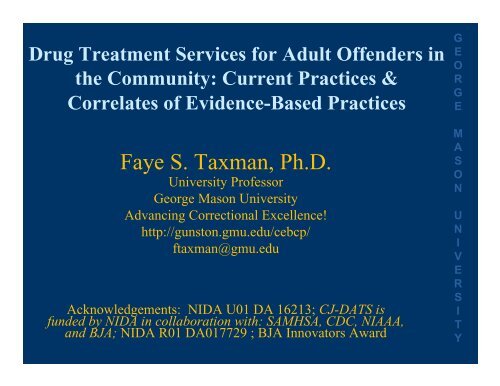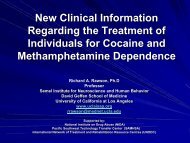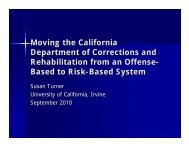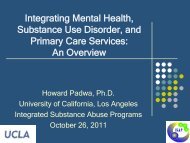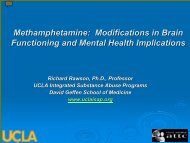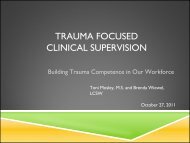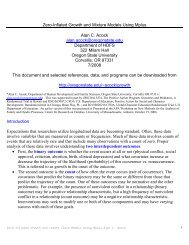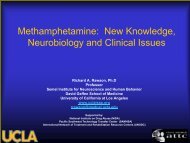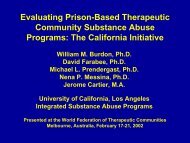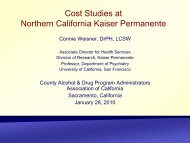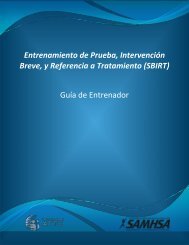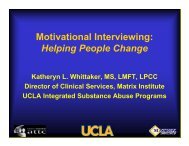Faye S. Taxman, Ph.D. - UCLA Integrated Substance Abuse Programs
Faye S. Taxman, Ph.D. - UCLA Integrated Substance Abuse Programs
Faye S. Taxman, Ph.D. - UCLA Integrated Substance Abuse Programs
Create successful ePaper yourself
Turn your PDF publications into a flip-book with our unique Google optimized e-Paper software.
Drug Treatment Services for Adult Offenders in<br />
the Community: Current Practices &<br />
Correlates of Evidence-Based Practices<br />
<strong>Faye</strong> S. <strong>Taxman</strong>, <strong>Ph</strong>.D.<br />
University Professor<br />
George Mason University<br />
Advancing Correctional Excellence!<br />
http://gunston.gmu.edu/cebcp/<br />
ftaxman@gmu.edu<br />
Acknowledgements: NIDA U01 DA 16213; CJ-DATS is<br />
funded by NIDA in collaboration with: SAMHSA, CDC, NIAAA,<br />
and BJA; NIDA R01 DA017729 ; BJA Innovators Award<br />
G<br />
E<br />
O<br />
R<br />
G<br />
E<br />
M<br />
A<br />
S<br />
O<br />
N<br />
U<br />
N<br />
I<br />
V<br />
E<br />
R<br />
S<br />
I<br />
T<br />
Y
Unlikely to Reduce Recidivism<br />
• Too few offenders exposed to treatment<br />
◄ Less than 11% can receive tx a year; on any given day, ~7.6% are in treatment<br />
• Treatment is inconsistent with needs<br />
– Not multi-dimensional—should address 3+ conditions including criminal values/thinking<br />
GMU
The Quest of EBPs<br />
• Evidence-based practices are specified systems,<br />
programs, and services that are based on research on<br />
facets that reduce criminal behavior OR reduce drug<br />
use<br />
• EBPs are a tool kit that can be used to advance actual<br />
practice, if the goal is to reduce RISK (recidivism)<br />
• To be effective, they need to be:<br />
– Embraced by the criminal justice-treatment community<br />
– <strong>Integrated</strong> into everyday practice<br />
– Require cross-agency efforts<br />
GMU
Offenders are not like other <strong>Substance</strong><br />
<strong>Abuse</strong>rs<br />
• Offenders Have Higher Rates of Psycho-Social Dysfunctional Than<br />
the General Population<br />
– <strong>Substance</strong> Use Disorders<br />
– Mental Health and Somatic Health Disorders<br />
– Educational Deficiencies<br />
• CJ Populations: 4 Times Greater SA Disorders<br />
GMU<br />
NSDUH<br />
2007
Drug-Involved Offenders are not like All Drug<br />
<strong>Abuse</strong>rs<br />
• Different configuration of “treatment” needs<br />
• <strong>Substance</strong> abuse treatment for offenders should address<br />
both the substance abuse and criminal risk factors.<br />
• Evidence-based practices (EBPs) and treatment<br />
techniques should advance treatment access and<br />
retention<br />
• The role of criminal justice agencies—courts,<br />
probation, parole, pretrial—should be partners with<br />
treatment agencies; emphasis on behavioral<br />
management strategies<br />
• Correctional agencies are pursuing EBPs which should<br />
open the doors to advance treatment programs<br />
GMU
What Works for Offenders?<br />
• ASSESSMENT & CASE PLANNING: Use standard tools<br />
to identify problem severity and link to programming<br />
• TREATMENT<br />
– Treatment that is multi-dimensional, includes criminogenic risk<br />
factors & criminal thinking<br />
– Address co-occurring disorders, criminogenic factors, etc.<br />
– Skill building, recovery models, not traditional<br />
alcohol/educational programs and outpatient programs<br />
– Dosage (length of treatment) is important through stages:<br />
motivate, change, reinforce<br />
• COMPLIANCE MANAGEMENT: Rewards & Incentives<br />
• WORKING ALLIANCE: Rapport, Relationship<br />
GMU
Multidisciplinary Problem of Offenders<br />
No Use<br />
30%<br />
Other TX ..Criminal<br />
Thinking/Mental<br />
Health<br />
User<br />
19%<br />
Public Safety Risk<br />
<strong>Abuse</strong><br />
20%<br />
ADDICT<br />
31%<br />
Education Outpatient Intensive OPT Residential<br />
GMU
National Surveys: Response Rates<br />
• Survey administered via mail<br />
• Multi-level (state agency executive, facility administrator, staff, tx providers, drug court<br />
coordinators)<br />
• No differences in response rates based on region and facility type<br />
• Criminal Justice Treatment Practices<br />
– N = 1,902<br />
– Adult: 67% Administrators, 75% State Executives<br />
– Juveniles: 54% Administrators, 70% State Executives<br />
<strong>Taxman</strong>, et al 2007; Melnick, et al 2008; <strong>Taxman</strong> and Perdoni, in press<br />
GMU
Setting Mean<br />
EBPs<br />
Adopted<br />
Adult Prison 5.6<br />
Adult Jail 3.9<br />
Adult CC 5<br />
Juvenile Res. 5.7<br />
Juvenile CC 4.8<br />
Drug Court 5.6<br />
The Challenge: Adopting EBPs<br />
The Greater Challenge: Implementation<br />
Friedmann, <strong>Taxman</strong>, & Henderson, 2007: Young, Dembo, & Henderson, 2007; Henderson, <strong>Taxman</strong> & Young, 2008<br />
GMU
% of Respondents Providing EBPs<br />
% of Agencies<br />
• = Treatment directors were not assessed on this item<br />
^ = Facility administrators were not assessed on this item<br />
~ = Adult program treatment directors/facility administrators not assessed on this item<br />
GMU
Should Screen for…<br />
Criminal Justice Risk<br />
• Actuarial based Models<br />
• Historically used to<br />
determine sanction<br />
• Main Factors<br />
– Age of first arrest<br />
– Number of arrests and/or convictions<br />
– Number of failed attempts on<br />
probation (or parole)<br />
– Number of incarcerations<br />
– Number of escapes<br />
– <strong>Substance</strong> <strong>Abuse</strong><br />
• Main Tools:<br />
– Composite Score of Criminal History<br />
– Wisconsin Risk/Needs**<br />
– Level of Service Inventory<br />
– Other Tools (Specialized)<br />
**Most Frequently used<br />
<strong>Substance</strong> <strong>Abuse</strong><br />
• Screen for SA Problem<br />
(Based on DSM-IV)<br />
• Triage Method<br />
• In CJ, used to refer to<br />
clinical assessment<br />
• Many tools exist:<br />
– CSAT’s SSI<br />
– ASI**<br />
• Co-Occurring Disorders<br />
GMU
Actuarial Risk Tools Identify<br />
Likelihood of Failure: Yet, Few In<br />
Place<br />
GMU
Standardized SA Tool is More Prevalent<br />
Dr Tx Prison: ASI (55%), TCUDS-II (39%)/Generic Prison: SASSI (39%),<br />
TCUDS-II or ASI (33%)/Jail: ASI (58%), MAST (29%)/State Comm Corr:<br />
SASSI (58%), ASI (47%)/Local Comm Corr: SASSI (46%), ASI (43%)<br />
Chi-Square=17.8, p
Tx Practices in “Practices”<br />
% Administrators Reporting Facility Use<br />
• 20% report the use of Cognitive Behavioral Treatments;<br />
few use manuals<br />
<strong>Taxman</strong>, Perdoni & Harrison, 2007; Young, Dembo, & Henderson, 2007<br />
GMU
What Matters in Adoption of EBPS?<br />
Overview of NCJTP Findings<br />
Qualities of<br />
Leaders<br />
1. Community<br />
Setting<br />
2 Administrator:<br />
•Human Services<br />
• Increased Knowledge of<br />
EBPs<br />
•Supports Rehabilitation<br />
•Pursue Reforms from<br />
Clinical Perspective<br />
3. State Executive<br />
Support (even for county)<br />
Organizational<br />
Culture &<br />
Climate<br />
Learning<br />
Performance<br />
Emphasis Quality<br />
Tx<br />
State Support*<br />
Friedmann, <strong>Taxman</strong>, & Henderson, 2007: Henderson, <strong>Taxman</strong> & Young,<br />
2008<br />
Training<br />
Resources<br />
Secure <strong>Ph</strong>ysical<br />
Facilities<br />
Internal Support<br />
Training<br />
Resources<br />
Network<br />
Connections<br />
Integration<br />
GMU
Advances to Current Practice<br />
• Use Standardized Risk Tool, SA Tool, Co-occurring<br />
Disorder Tool<br />
• Ensure that Treatment has phases—need longer time<br />
for CJ clients than SUD clients<br />
• Work with CJ Agencies to have ACTIVE Referral<br />
Processes —set appointments, share information,<br />
integrated, joint processing<br />
• Integrate CJ Interventions with SA Interventions—<br />
Drug Courts should be geared to High Risk Offenders<br />
between IOP and Residential Care<br />
• Use Contingency Management Protocols<br />
GMU
Working with CJ in Partnerships<br />
http://www.nicic.org/Library/020095<br />
TIP 44.<br />
<strong>Substance</strong><br />
<strong>Abuse</strong><br />
Treatment for<br />
Adults in the<br />
Criminal<br />
Justice<br />
System<br />
GMU
No Integration<br />
Services/Drug<br />
abuse treatment<br />
18<br />
Criminal<br />
justice
Networked Coordinated Cooperative Consolidated <strong>Integrated</strong><br />
Services/Drug<br />
abuse treatment<br />
Informal communications<br />
19<br />
Criminal<br />
justice
Networked Coordinated Cooperative Consolidated <strong>Integrated</strong><br />
Services/Drug<br />
abuse treatment<br />
Coordinated Requirements<br />
Informal communications<br />
Some formal communications<br />
20<br />
Criminal<br />
justice
Networked Coordinated Cooperative Consolidated <strong>Integrated</strong><br />
Services/Drug<br />
abuse treatment<br />
Formal Agreements<br />
Joint Goal Setting<br />
Joint Activities<br />
Informal Communications<br />
Formal Communications<br />
21<br />
Criminal<br />
justice
Networked Coordinated Cooperative Consolidated <strong>Integrated</strong><br />
Services/Drug<br />
abuse treatment<br />
Umbrella<br />
Resource<br />
Allocations<br />
Administrative<br />
Functions<br />
Informal Communications<br />
Formal Communications<br />
22<br />
Criminal<br />
justice
Networked Coordinated Cooperative Consolidated <strong>Integrated</strong><br />
Services/Drug<br />
abuse treatment<br />
+<br />
23<br />
Criminal<br />
justice
Even Drug Courts are not <strong>Integrated</strong> in the<br />
Processes<br />
Mean % of<br />
Team Involved 59% 37% 39% 44% 47%<br />
75%+ of All<br />
Staff Involved 34% 0% 2% 1% 5%<br />
Few<br />
involved<br />
Arrest Outcome<br />
GMU
11 Service Delivery Techniques to Reach<br />
Integration<br />
• Share Information on Overall Needs (Networking)<br />
• Develop Common Eligibility Criteria for Services<br />
• Develop Written Program that is delivered by multiple agencies<br />
• Joint Staffing in the Program<br />
• Joint Policy Manual that all agencies use<br />
• Pooled Funding for the program<br />
• Modified Existing Processes and programs<br />
• Share Budget with another agency<br />
• Share Oversight on a program<br />
• Cross Training of Staff<br />
• Written MOU for this Service/Program<br />
GMU
Probation/Parole & TX Integration in Colorado<br />
Most Typical Activities:<br />
• Share Information<br />
• Develop Client Eligibility<br />
Across Agencies<br />
• Written Agreements<br />
• Joint Staffing of Program<br />
• Treatment Provider<br />
Develops Tx Plan<br />
• Share Operational<br />
Oversight<br />
Major Activities NOT Used in<br />
State A<br />
Developed Joint Policies and<br />
Procedures Manuals<br />
Pooled Funding for Some<br />
Services<br />
Modified Program/Service<br />
Protocols to Meet Needs of<br />
Other Agency<br />
Share Oversight of Some<br />
<strong>Programs</strong>/ Services<br />
Written Protocols for Sharing<br />
Information Client<br />
Information<br />
GMU
# Activities: Probation & Other Agencies<br />
10<br />
8<br />
6<br />
4<br />
2<br />
0<br />
7.8<br />
5.4<br />
2.1<br />
1.4 1.4<br />
6.1<br />
Average # Activities<br />
Treatment Courts Prosecutor<br />
Defenders Law Enforcment National Drug Courts<br />
National P/P National Jails Nationals Prisons<br />
4.5<br />
3.7<br />
3.2
Perception of Activities-District 1<br />
Pooled Funding<br />
Modified Service<br />
Joint P/P Manuals<br />
Joint Staffing<br />
Written Agreements<br />
Eligibility<br />
Share Infomration<br />
0 0.2 0.4 0.6 0.8 1<br />
Court Tx Agency Probation
Perception of Activities-District 2<br />
Pooled Funding<br />
Modified Service<br />
Joint P/P Manuals<br />
Joint Staffing<br />
Written Agreements<br />
Eligibility<br />
Share Infomration<br />
0 0.2 0.4 0.6 0.8 1<br />
Court Tx Agency Probation
Factors that Support Integration<br />
• Correctional Administrators believe they<br />
have community support<br />
• Correctional Administrators believe in<br />
offender change<br />
• Correctional System adopts Evidence-based<br />
practices<br />
DEGREE of NETWORKNESS DEPENDS<br />
ON ATTITUDES of COMMUNITY<br />
PARTNERS
What are the issues to<br />
achieving implementation?
SA TX Compared to Other <strong>Programs</strong><br />
•High Believers: More use of EBPs, County run, in Midwest/Northeast, stronger belief in<br />
rehabilitation<br />
•Low Believers: Southern regions<br />
•Equal/Ambivalence: Marginal use of EBPS, Support Rehabilitation, in South/Northeast region<br />
Henderson & <strong>Taxman</strong>, 2009<br />
GMU
Competing Values:<br />
Importance of SUD Treatment to other CJ Services<br />
GMU
What style of reform do CJ Agencies pursue?<br />
Clinical orientation: Focus on treatment such as therapies and working alliance<br />
CJ Innovators: Focus on punishment (sanctions), drug testing, treatment<br />
None: No clear direction, responsive to setting<br />
GMU
EBP by Type of CJ Innovators<br />
GMU
Advances in Changing CJ Cultures<br />
• Correctional cultures need to embrace behavioral management<br />
techniques of engagement, clear expectations, and<br />
rewards/consequences<br />
• Change the role of probation/parole and correctional officers<br />
from security to facilitator of change<br />
• Improves correctional environment by emphasizing that<br />
accountability is self-management of behavior<br />
• Use evidence-based practices<br />
– Shown to reduce recidivism and technical violations<br />
– Creates culture of accountability<br />
– Alters role of officer to be a facilitator of change/behavioral manager<br />
GMU
Behavioral Management Strategies in<br />
• Unclear rules<br />
• Discretionary procedures<br />
• CJ Procedures<br />
• Focus on Conditions,<br />
not goals<br />
• Outlaw persona<br />
Supervision<br />
• Deportment/Respect<br />
– Office Decorum<br />
– Citizen persona<br />
• Social Learning Model<br />
– Mutually Develop Plan Tied to<br />
Criminogenic Traits<br />
– Feedback on Risk/Need,<br />
Supervision Plan, Progress<br />
– Focus on Prosocial Networks<br />
– Tie to Stages of Supervision<br />
– Positive Reinforcers<br />
• Clarify Expectations 37for<br />
Success
Positive Findings for new Behavorial<br />
Management Strategies<br />
Reduced Recidivism<br />
Reduced Technical Violations<br />
Increased Access to Treatment<br />
Increased Retention in Treatment<br />
*p
The Failure to Build Collaborations Limits the<br />
Mission of Corrections to include EBPs and<br />
Achieve Outcomes<br />
• Routine, existing practices need integration to improve the<br />
climate for offender change—people can change at various<br />
dimensions<br />
• Use of working relationships with other organizations<br />
• Emphasis on recidivism reduction practices<br />
• Training of staff<br />
• Staff Orientation<br />
• Types of Administrators hired<br />
• Legitimacy of correctional practice<br />
A renewed focus on viewing corrections as a service provider<br />
(public health) will create better outcomes<br />
GMU
Useful Resources<br />
GMU
Special Edition of Drug and Alcohol Dependence,<br />
August 2009<br />
Fletcher, B. W., Lehman, W. E., Wexler, H. K., Melnick, G., <strong>Taxman</strong>, F. S., & Young, D. W. (2009). Measuring collaboration and<br />
integration activities in criminal justice and substance abuse treatment agencies. Drug and Alcohol Dependence, 103(Supplement 1), S54-<br />
S64.<br />
Henderson, C. E., & <strong>Taxman</strong>, F. S. (2009). Competing values among criminal justice administrators: The importance of substance abuse<br />
treatment. Drug and Alcohol Dependence, 103(Supplement 1), S7-S16.<br />
Henderson, C. E., Young, D. W., Farrell, J., & <strong>Taxman</strong>, F. S. (2009). Associations among state and local organizational contexts: Use of<br />
evidence-based practices in the criminal justice system. Drug and Alcohol Dependence, 103(Supplement 1), S23-S32.<br />
Lehman, W. E., FLETCHER, B. W., Wexler, H. K., & Melnick, G. (2009). Organizational factors and collaboration and integration<br />
activities in criminal justice and drug abuse treatment agencies. Drug and Alcohol Dependence, 103(Supplement 1), S65-S72.<br />
McCarty, D., & Chandler, R. K. (2009). Understanding the importance of organizational and system variables on addiction treatment<br />
services within criminal justice settings. Drug and Alcohol Dependence, 103(Supplement 1), S91-S93.<br />
Melnick, G., Ulaszek, W. R., Lin, H., & Wexler, H. K. (2009). When goals diverge: Staff consensus and the organizational climate. Drug<br />
and Alcohol Dependence, 103(Supplement 1), S17-S22.<br />
Oser, C. B., Knudsen, H. K., Staton-Tindall, M., <strong>Taxman</strong>, F., & Leukefeld, C. (2009). Organizational-level correlates of the provision of<br />
detoxification services and medication-based treatments for substance abuse in correctional institutions. Drug and Alcohol Dependence,<br />
103(Supplement 1), S73-S81.<br />
Oser, C., Knudsen, H., Staton-Tindall, M., & Leukefeld, C. (2009). The adoption of wraparound services among substance abuse treatment<br />
organizations serving criminal offenders: The role of a women-specific program. Drug and Alcohol Dependence, 103(Supplement 1), S82-<br />
S90.<br />
<strong>Taxman</strong>, F. S., & Kitsantas, P. (2009). Availability and capacity of substance abuse programs in correctional settings: A classification and<br />
regression tree analysis. Drug and Alcohol Dependence, 103(Supplement 1), S43-S53.<br />
<strong>Taxman</strong>, F. S., Henderson, C. E., & Belenko, S. (2009). Organizational context, systems change, and adopting treatment delivery systems<br />
in the criminal justice system. Drug and Alcohol Dependence, 103(Supplement 1), S1-S6.<br />
Young, D. W., Farrell, J. L., Henderson, C. E., & <strong>Taxman</strong>, F. S. (2009). Filling service gaps: Providing intensive treatment services for<br />
offenders. Drug and Alcohol Dependence, 103(Supplement 1), S33-S42.<br />
GMU


